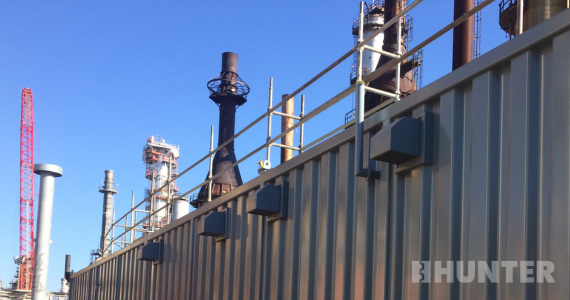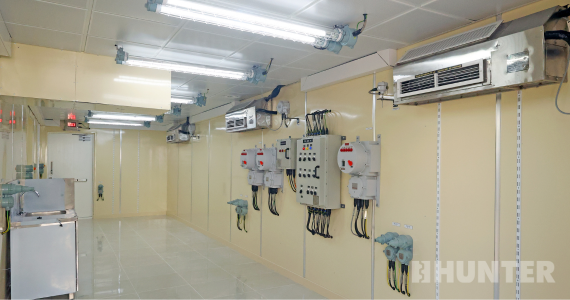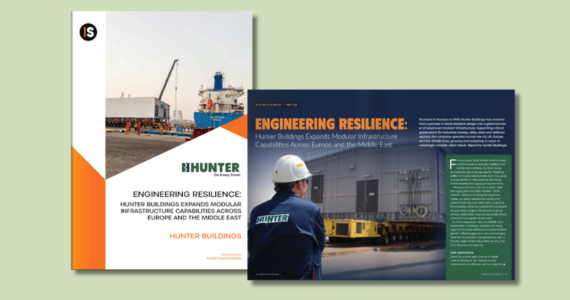Industrial operations are no strangers to planned production halts. Whether related to routine maintenance, critical repairs or facility upgrades, the industrial building shutdown or turnaround plays a vital role in ensuring safety, efficiency and regulatory compliance. Even so, it isn’t without its hurdles.
The increased activity generated on an industrial site makes temporary infrastructure necessary to support efficient workflow while maintaining a safe, organized environment. Here, Hunter’s custom modular construction experts cover the challenges plant shutdown and turnaround events introduce to facilities, the role specialized buildings play in such work and considerations for ensuring your custom structure supports your operational needs.

Why Do Plant Shutdown and Turnaround Events Require Specialized Buildings?
Industrial plant shutdown and turnaround practices are planned production halts that allow crews to enter a facility to carry out maintenance or repair work, or to make necessary upgrades. Although the practices are similar, turnarounds are more all-encompassing, typically involving more areas of an industrial plant and lasting a longer amount of time than a shutdown would. Let’s take a look at the issues that come into play when new people, materials and equipment are introduced to a site — and ways the right support structures can help.
- Improved Project Efficiency: Plant turnaround events often require extensive — and time-consuming — travel between safe areas and worksites within blast zones. For European operations in particular, much of that travel takes place via bicycle. By incorporating structures specifically rated for use in blast zones, it’s possible to house necessary tools, equipment or tasks closer to the jobsite. This saves time while also allowing teams to reallocate costly manpower to areas where it will be better served. In addition, it offers improved worker safety.
- Temporary Workspace Solutions: With extra personnel on-site, plant shutdown and turnaround scenarios often necessitate additional space for offices, medical facilities and areas for meetings and breaks. Short-term buildings are an ideal solution, providing additional space with minimal disruption to the surrounding facility.
- Storage Support: Turnarounds and shutdowns often require vast amounts of parts, equipment, chemicals and other materials — all of which must be stored safely and securely, while remaining accessible. Temporary buildings can serve as staging areas or tool storage, providing space to house such items while keeping them organized.
- Safe Surroundings in High-Risk Environments: Safety is a top priority in industrial environments where hazardous materials and heavy equipment present concerns. Specialized structures — particularly those equipped with safety considerations such as blast ratings, filtration packages, and fire detection and suppression systems — offer improved protection for personnel as they carry out their work. Blast-resistant modular buildings and forced entry/ballistic-resistant buildings are just two examples of structures that provide improved safety while supporting operations.

Why Modular Industrial Buildings Make Sense in Turnaround or Shutdown Scenarios
The temporary nature of shutdown and turnaround practices makes modular industrial buildings an ideal option. Not only are they quick and cost-effective to build, but their sheer versatility allows them to serve a wide range of industrial needs.
- Economical Build Options: Modular industrial buildings cost about half as much as structures that employ traditional construction methods, while their short construction and installation timelines also allow companies to save on labor costs. Saved funds can be put to use elsewhere.
- Rapid Deployment: Although shutdowns and turnarounds are often planned months — if not years — in advance, timing remains critical. The majority of a modular industrial building’s construction takes place in controlled manufacturing environment, meaning builds rarely fall victim to weather-related disruptions and the like. Construction takes about half the time of what you would experience with a traditional build, and modular structures are approximately 90% complete by the time they reach their destination. That means faster installation. These shortened timelines minimize downtime and help keep work on schedule.
- Rugged Durability: Modular industrial buildings are made of high-grade materials able to withstand extreme weather while offering protection against both the elements and jobsite hazards. Strength can be further enhanced with customizations such as reinforced building materials and exterior coatings. Blast-resistant modules are commonly incorporated into plant shutdown and turnaround operations.
- Sustainability Benefits: Construction of modular industrial buildings requires less energy use, while also resulting in less material waste as compared to traditional construction methods. And the sustainability benefits extend long after a build reaches completion. These buildings are easily relocated once projects for which they were initially commissioned come to an end. The same modular industrial building that serves an operation’s turnaround and shutdown needs in one location can continue to do so in other regions for decades to come.
- Customization to Meet Specific Needs: As we like to say at Hunter, modular industrial buildings are limited solely by the imagination. Such structures are able to accommodate a virtually endless list of operational needs. Whether a shutdown or turnaround requires temperature-controlled storage, protection against potential industrial blasts, reinforcement against forced entry or a simple color update to blend with a plant’s surroundings, if you can envision it, a quality modular building manufacturer can make it happen.
- Budget-Friendly Rental Options: Although blast-resistant modules (BRMs) and related structures are versatile and efficient, they’re also a substantial investment. For operations seeking to keep project budgets under control — or whose structural needs won’t extend beyond the plant shutdown or turnaround project — building rentals are an effective solution. At Hunter, we offer a full range of custom modular and blast-resistant modular buildings available for short-term or long-term rental around the globe.

Custom Modular Building Considerations for Plant Shutdowns and Turnarounds
The key advantage of incorporating a custom modular building into shutdown and turnaround operations is the fact that these structures can be tailored to meet the unique needs of a project and space. We recommend working closely with your building manufacturer to determine the role (or roles) your structure will play — and customizations that might improve safety or efficiency. Here are some options to consider.
- Enhanced Safety Features: Blast resistance ratings, positive pressure considerations, use of fire-resistant materials and safeguards against toxic gas ingress are just a few upgrades with the potential to protect personnel, systems and equipment in high-risk industrial areas.
- Climate Control Systems: Heating, ventilation and air conditioning (HVAC) systems can help create comfortable interior environments while looking out for the health of your people and equipment. Air filtration systems, meanwhile, are crucial for operations near hazardous materials and can ensure air remains safe to breathe.
- Accommodations for Specialized Equipment: Reinforced flooring can make it possible for a custom modular industrial building to house heavy machinery or facilitate equipment storage. Meanwhile, integrated technologies such as Wi-Fi and data networking can ensure uninterrupted communication between systems — or crews — as turnaround and shutdown efforts continue.
- Worker Considerations: Shutdown and turnaround work often requires crews to be on the job for extensive stretches of time. Considerations such as kitchenettes or cafeterias where they can enjoy a warm meal, break rooms where they can rest and recharge and locker areas where they can store their valuables can all contribute to happier, more productive crews. In addition, restroom and shower accommodations can prove helpful when temporarily expanding the workforce present in an industrial setting.
With a custom modular building, plant shutdown and turnaround events have the potential to run more smoothly and efficiently. It’s all about understanding the unique needs of your crew members and operations — and tailoring the structure to bring success within reach. If you have questions about any of the above, or if you’re interested in learning how you can customize a Hunter modular building for your plant shutdown and turnaround, reach out to our modular construction pros at any time. Our team is happy to help.


